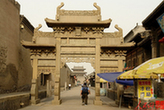Brief Introduction
Lies in central Shandong Province, spanning the ranges of Tai'an and Jinan Cities. It covers an area of 550 sq. km. It was known in ancient times as Daishan until it was renamed Taishan in the Spring and Autumn Period, and was regarded as pre-eminent among China's Five Holy Mountains. 72 Chinese emperors of various dynasties made pilgrimages to Mt. Tai for sacrificial and other ceremonial purposes. They include Emperor Qin Shihuang, Emperor Wudi of the Han Dynasty, Emperor Xuanzong of the Tang Dynasty and Emperor Qianlong of the Qing Dynasty.
Mt. Tai is endowed with many scenic spots. A large number of them were given names in ancient times. They include 112 peaks, 98 precipices, 18 caves, 58 odd-shaped rocks, 102 streams and valleys, 56 pools and waterfalls, and 64 springs. Vegetation covers 79.9% of the area. The flora is known to comprise 989 species of 144 families.
Mt. Tai also boasts cultural heritage with an incessant history of several thousand years. Currently on the mountain, there are 22 ancient architectural complexes, 97 ruins, 819 stone tablets and 1,800 stone inscriptions, which provide a natural museum for the study of ancient history and calligraphy. Main sites of interest are the Tiankuang Temple, Nantian Gate, Azure Cloud Temple, Peak for Viewing the Sun, Sutra Rock Valley, and Helong Pool.
Mt. Tai is a mountain of outstanding value from the point of view of aesthetics, science, history and culture.
Cultural Heritage
Mt. Tai is one of the birthplaces of the ancient Chinese civilization along the Yellow River. Evidence of human activities includes two flourishing cultures -- the Dawenkou Culture to the north and the Longshan Culture to the south of the mountain. During the Warring States Period, a 500-km-long wall was built from Mt. Tai to the Yellow Sea. Scenic spots related to the famous ancient sage Confucius are the Confucian Temple, places where Confucius climbed Taishan and viewed the scenery, Menghugou, etc.
Mt. Tai has an extremely rich cultural heritage. It has always been regarded as pre-eminent among China's five sacred mountains. It was also a symbol of power. Emperors of different dynasties have made pilgrimages to it for sacrificial purposes shortly after they came to the throne or when the land enjoyed peaceful and prosperous times. Poets and literary scholars of each dynasty also visited Mt. Tai. Numerous rock inscriptions and stone tablets bear testimony to such visits. Renowned scholars, including Confucius, Sima Qian, Cao Zhi, Li Bai, Du Fu, composed poetry and prose and left their calligraphy on the mountain. The currently preserved 97 sites and 22 ancient building complexes provide materials for research into China's ancient architecture.
Natural Heritage
Mt. Tai rises abruptly to 1,300 m above the vast plain of north China. The sharp contrast between Mt. Tai and its surrounding plain and hills makes it especially majestic.
Mt. Tai rises from about 150 m above sea level (north of Tai'an City), to the Middle Gate to Heaven at 847 m, to the Southern Gate to Heaven at 1,460 m, and finally to the Jade Emperor Peak at 1,545 m. Standing in the central part of Shandong, the mountain stretches for 100 km. Its base covers an area of 426 sq. km. The wide base and huge body of the mountain gives an impression of solidity and dignity. Chinese people tend to describe a situation as being as stable as Mt. Tai or a matter as being as weighty as Mt. Tai, giving clear evidence of such an impression.
Mt. Tai is a symbol of loftiness and grandeur, characterized by numerous old but still green pines and cypresses, towering precipices comprising metamorphic rock and granite, and ever-changing seas of clouds. Other features include the Palace of the Goddess Doumu, the one-hundred-zhang (one zhang is three and one third m) Cliff, the Immortal's Bridge, the Stone Valley, etc.
The Pre-eminent of the Five Holy Mountains
Mt. Tai is also called Daishan, Daizong or Taiyue. Mt. Tai lies west of the Yellow Sea and east of the Yellow River, spanning Tai'an City in the south and Jinan City in the north. The scenic area covers 125 square km. Its main peak (Jade Emperor Peak) is 1,545 m high. It is 8.9 km from the Temple of the God of Mt. Tai at the foot of the mountain to the Jade Emperor Peak, with over 6,660 steps, 60 major scenic sites, nearly 1,000 cliffside sculptures and over 200 stone tablets. Mt. Tai is regarded as pre-eminent among the Five Holy Mountains.






Why not rent a boyfriend, or girlfriend to please parents during the Spring Festival?